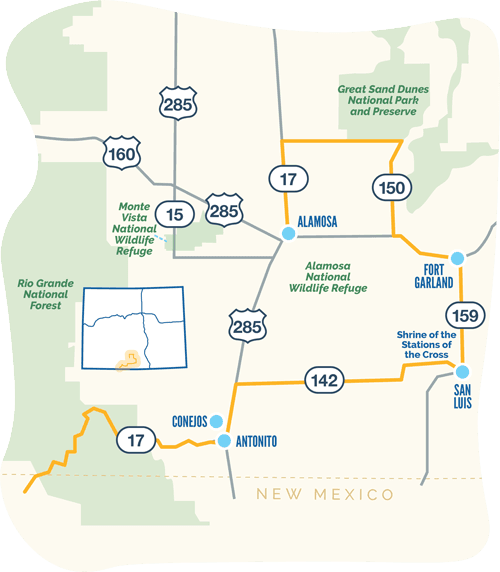Larger than the state of Massachusetts, the San Luis Valley is one of Colorado’s most impressive landscapes, with massive sand dunes, nine 14,000-foot peaks ringing its edge and the historic Rio Grande River pulsing through its heart.



Larger than the state of Massachusetts, the San Luis Valley is one of Colorado’s most impressive landscapes, with massive sand dunes, nine 14,000-foot peaks ringing its edge and the historic Rio Grande River pulsing through its heart.



Los Caminos Antiguos byway explores the wide and flat expanse of the valley floor that served as a gateway into Colorado for Spanish explorers arriving from the south. As a result, the state’s oldest communities are found here. The historic byway takes you through the heart of the Sangre de Cristo National Heritage Area and its rich historic, cultural and natural resources. Enjoy alpine views of the magnificent Sangre de Cristo Range along the way.
Start your tour in Alamosa, a tightly knit community of 8,000, and the central crossroads of commerce and travel in the valley. Here stop for a latte at Milagros Coffee House, where you can admire the works of Alamosa artists before marveling at pottery and Native American weavings at the Luther Bean Museum.
Monte Vista National Wildlife Refuge, located west of Alamosa, is a worthy detour. A bird-watcher’s paradise, the annual sandhill crane migration happens between mid-March and mid-October.
Next along the byway, head to Great Sand Dunes National Park and Preserve for a mystifying sight. Pale in color by day and gold by dusk, the dunes’ towering majesty has long captivated visitors. Kids and adults alike sled down sand dunes year-round; it’s also a peaceful place for hiking, camping and picnicking. The rural park is a favorite for nighttime stargazers.
A hike to Zapata Falls offers breathtaking views of the dunes best enjoyed around sunrise or sunset. Extend your trip to find refreshment at the hot-springs-fed Sand Dunes Swimming Pool in Hooper. Stop to see the Trujillo Homesteads National Historic Landmark to better grasp regional ranching history and its Hispanic influence.
Continue driving to Fort Garland, a preserved military outpost that functioned in the valley from 1858 to 1883. Tour original adobe buildings at Fort Garland Museum & Cultural Center. An exhibit titled “Buffalo Soldiers West” explores the role of African-American soldiers in the expansion of the West and the Plains Wars of the late 1800s.
After Fort Garland, head to San Luis, which was established in 1851 and is Colorado’s oldest town. While you’re there, climb a half-mile trail and view 15 bronze sculptures depicting Christ’s passion and resurrection as part of the Shrine of the Stations of the Cross; don’t miss the arresting adobe Capilla at the top. Other must-see attractions include Plaza de San Luis de la Culebra Historic District and San Luis Peoples Market (formerly R&R Market), Colorado’s oldest continuously operating business.
In Conejos, or “rabbit” in Spanish, visit Colorado’s oldest church — Our Lady of Guadalupe. Built in 1858 near the New Mexico border, it’s both stately and architecturally unique. Superb fly-fishing opportunities are available around Conejos as well.
At the next stop, get out of the car and board the Cumbres & Toltec Scenic Railroad in Antonito, an authentic original of the narrow-gauge railroad era. It’s also the highest and longest of its type in the country.
Then finish your route atop beautiful La Manga Pass, whose aspen-shaded reaches offer a magnificent conclusion to your tour.
Events on the calendar: Alamosa Round-Up Rodeo, Manassa Pioneer Days, Monte Vista Crane Festival